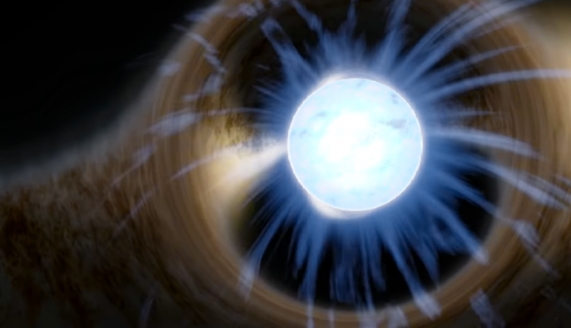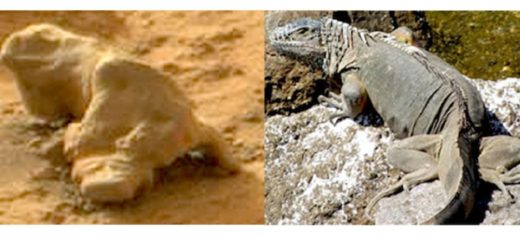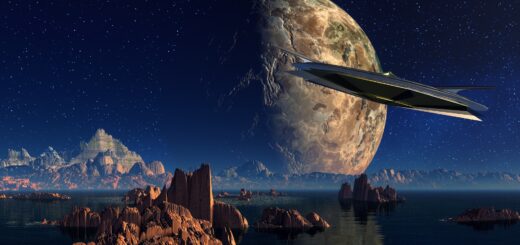Neutron-Star Mountains Are Tiny (But You Can’t Climb ’Em)

Neutron-star mountains
For decades, astronomers have maintained that mountains on tiny, dense neutron stars would be just millimeters tall. Minuscule mountains on neutron stars are a cherished theoretical concept. Now a study has put some new, hard numbers toward the idea. Fabian Gittins at the University of Southampton led the new research. He presented it at NAM2021, a meeting of astronomers held July 19-21, 2021, at the University of Bath in the U.K. The new work shows that the mountains on neutron stars are only fractions of millimeters tall. Even so, you still couldn’t climb ’em.
The researchers published a peer-reviewed paper about neutron-star mountains in the Monthly Notices of the Royal Astronomical Society.
How big are ‘mountains’ on neutron stars?
Here’s how Gittins introduced the new study to other astronomers at NAM2021:
The maximum [mountain] that a neutron star can sustain is of great interest. In this talk, I will outline how neutron-star mountains are calculated, while identifying issues with previous studies relating to boundary conditions. In light of these issues, I shall present a novel scheme for modeling neutron-star mountains …
Because, of course, all we know of neutron-star mountains comes from computer models. And it seems weird to think of stars as having mountains at all. But neutron stars aren’t ordinary stars. They are the dead, collapsed cores of former stars. And they’re some of the densest objects in the universe. A typical neutron star is very small, about six miles (10 km) in diameter, in contrast to the 865,370-mile (about 1.4 million-km) diameter of our sun. Yes, neutron stars are as massive as our sun. The “mountains” are just tiny deformations of their surfaces.
Astronomers like to say that neutron stars are almost perfectly smooth spheres. They are smoother than billiard balls. The sub-millimeter height of their mountains doesn’t alter that smoothness.
Why are they so smooth? It’s because gravity depends on two things: mass and distance. A neutron star has a lot of mass squeezed into a tiny space. So, when you’re standing on its surface, you’re at only a tiny distance from its center of mass. And so neutron stars exert a mighty gravitational pull. The gravity of a neutron star squashes everything down about as much as it can possibly be squashed.
Calculating the size of neutron-star mountains
How did the researchers determine the height of these minuscule mountains?
They used computer modeling to create realistic “replicas” of neutron stars. Then they subjected the neutron star replica to various mathematical “forces.” They studied the effects of different forces to figure out how the mountains were created, and why they are so small.
By also taking into account the role of nuclear material in the neutron stars, which could help support the mountain structures, the team found a surprising result. The mountains were tiny, only a fraction of a millimeter tall at most. That’s about a hundred times smaller than previous estimates. These mountains are so small, you’d need a magnifying glass to get a good look at one!
The results answer a long-standing question as to the size of mountains on neutron stars. Gittins commented:
For the past two decades, there has been much interest in understanding how large these mountains can be before the crust of the neutron star breaks, and the mountain can no longer be supported.
These results show how neutron stars truly are remarkably spherical objects. Additionally, they suggest that observing gravitational waves from rotating neutron stars may be even more challenging than previously thought.
‘Mountains’ on neutron stars. Part of a glowing blue sphere with dim features on it.
There are mountains on neutron stars, but they are less than a millimeter tall. Image via Science Channel/ YouTube.
Man in suit and tie with grass and trees behind him.
The new study about mountains in neutron stars was led by Fabian Gittins at the University of Southampton. Image via University of Southampton.
What are neutron stars?
Neutron stars are the remaining dead, collapsed core of a star that has exploded as a supernova. Neutron stars tend to be about 1.4 times the mass of the sun, but are very small, only about the size of an average city. They are extremely dense: a tablespoon of neutron star material would weigh more than 1 billion U.S. tons (900 billion kg)!
Neutron stars may have thin crusts, and their interior composition is still debated. A neutron star does not generate any light or heat of its own after its formation. Over millions of years its latent heat will gradually cool from an initial 1 million degrees Fahrenheit (556,000 degrees Celsius), eventually ending its life cold and dead.
Read more: What is a neutron star?
Overhead view of Manhattan Island with large white sphere.
The size of a typical neutron star compared to Manhattan Island. Image via NASA/ Goddard Space Flight Center.
Cross-section of bluish sphere with layers from outer crust to inner core labeled with explanatory text.
There’s still a lot that’s unknown about the structure of neutron stars. But this illustration shows what scientists think they look like, generally speaking. Image via Nature/ Quora.
Could you climb a neutron-star mountain?
By the way, of what use are neutron-star mountains? Could future space travelers go there and gain accolades by becoming the first to “climb” them? That’s a fun idea. After all, these mountains are less than a millimeter tall! Surely climbing them would be a breeze. But, don’t forget, the same fierce gravity that pulls on neutron-star mountains, squashing them down to less than millimeter-sized, would also affect you. You wouldn’t be able to lift your foot high enough to climb even so small a neutron-star mountain. As physics student Christopher Hansen wrote in Northwestern’s online science magazine Helix:
Before you can even think about climbing one of these mountains, gravity will spread you out into a miles-wide atomically-thin goop. My advice? Don’t go hiking on a neutron star.
Enough said!
Bottom line: Researchers in the U.K. have found that mountains on neutron stars are less than a millimeter tall. These dense, dead stars are nearly perfectly smooth spheres, much smoother, for example, than billiard balls.



 Creators of mankind
Creators of mankind Description of “Tall white aliens”
Description of “Tall white aliens” Where they came from?
Where they came from? About hostile civilizations
About hostile civilizations The war for the Earth
The war for the Earth “Tall white aliens” about eternal life
“Tall white aliens” about eternal life Video: “Nordic aliens”
Video: “Nordic aliens” Aliens
Aliens Alien encounters
Alien encounters The aliens base
The aliens base UFO
UFO Technology UFO
Technology UFO Underground civilization
Underground civilization Ancient alien artifacts
Ancient alien artifacts Military and UFO
Military and UFO Mysteries and hypotheses
Mysteries and hypotheses Scientific facts
Scientific facts


















